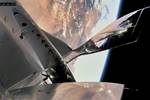Virgin Galactic completes first fully crewed spaceflight
All-composite VSS Unity completes the company’s fourth rocket-powered spaceflight and the first with a full crew.

Photo Credit: Virgin Galactic
(Mojave, Calif., U.S.) announced that VSS Unity — an all composite spacecraft — successfully reached space, completing the company’s fourth rocket-powered spaceflight.
According to Virgin Galactic, the flight was the VSS Unity’s 22nd test flight, and the first test flight with a full crew in the cabin. The crew fulfilled a number of test objectives related to the cabin and customer experience. The mission specialists in the cabin included Beth Moses, chief astronaut instructor, Colin Bennett, lead flight operations engineer, Sirisha Bandla, vice president of government affairs and research operations and the company’s founder, Richard Branson. The VSS Unity pilots were Dave Mackay and Michael Masucci, while Kelly Latimer and CJ Sturckow piloted the mothership, VMS Eve.
“Today is a historic moment for the new commercial space industry,” says Michael Colglazier, chief executive officer of Virgin Galactic. “With each successful mission we are paving the way for the next generation of astronauts.” VSS Unity achieved a speed of Mach 3 after being released from VMS Eve, says the company. The vehicle reached space, at an altitude of 53.5 miles, before gliding smoothly to a runway landing at Spaceport America, located in Las Cruces, New Mexico.
“Our mission is to make space more accessible to all,” adds Branson. “In that spirit, and with the successful flight of VSS Unity, I’m thrilled to announce a partnership with [Culver City, Calif., U.S.) and to inspire the next generation of dreamers.”
Related Content
-
The next-generation single-aisle: Implications for the composites industry
While the world continues to wait for new single-aisle program announcements from Airbus and Boeing, it’s clear composites will play a role in their fabrication. But in what ways, and what capacity?
-
Plant tour: Collins Aerospace, Riverside, Calif., U.S. and Almere, Netherlands
Composite Tier 1’s long history, acquisition of stamped parts pioneer Dutch Thermoplastic Components, advances roadmap for growth in thermoplastic composite parts.
-
Welding is not bonding
Discussion of the issues in our understanding of thermoplastic composite welded structures and certification of the latest materials and welding technologies for future airframes.



